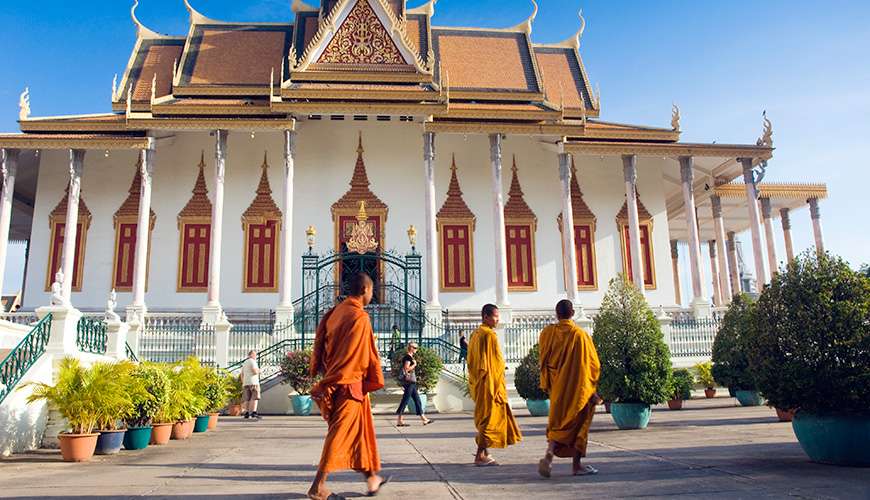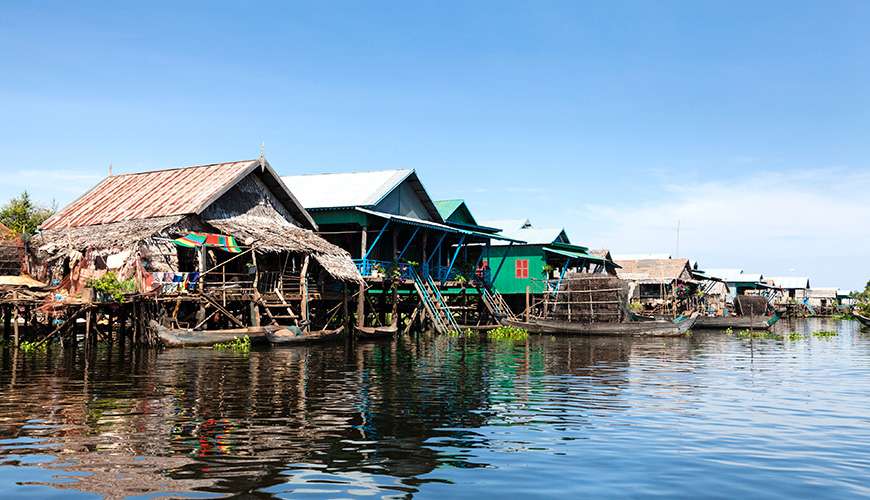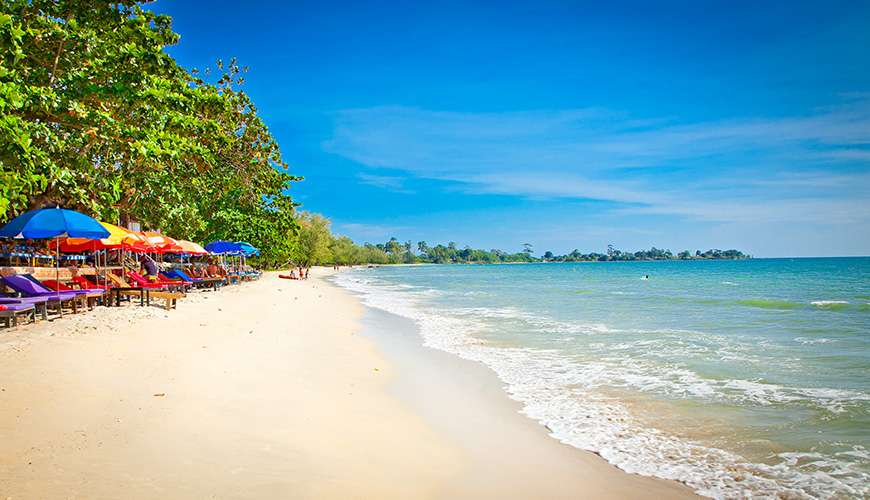Bisected by the Mekong River
Southern Cambodia consists of the Mekong flood plain in the east before rising up into the Cardamom and Elephant Mountains in the west, separating the floodplain from the coast.
In ancient times, during the country’s golden age, it was ruled by the powerful Khmer Empire, which dominated Indochina and Southeast Asia as a whole, until it went into a centuries long decline and finally collapsed for complex and not entirely understood reasons in the 15th century.

Saffron-clad monks and beautiful architecture can be found everywhere.
The fall of the Khmer ushered in what is now known as the “Dark Ages of Cambodia” where constant pressure from neighbouring Siam and Vietnam eventually led to the country accepting French Protectorate status and becoming part of the French colony in Indochina.
The period of Khmer Rouge rule from 1975-1981 left deep scars that can still be felt today. The brutal regime and the genocide they carried out would result in the deaths of approximately 25% of the entire population, and this fact is still visible in the demographics in the country.
The people in the region are incredibly friendly, as well as eager for travellers to visit their country and eventually for it to be known for something different than the dark days of the genocide. While over 90% of Cambodia is ethnically Khmer, in Phnomh Penh, the Sino-Khmer (Chinese Cambodians) dominate all aspects of life, forming a majority of the city’s population.
The climate is stable across the region, with temperatures everywhere averaging in the low 30’s. The rainy season runs from May to October, and the dry season from October to April, though the interior floodplain recieves far more rain than the coastal area beyond the mountain ranges.

Traditional Cambodian waterfront.
Once considered the most beautiful city in South East Asia, Phnom Penh has gone through some hard times since its heyday in the 1920’s, but has by now recovered and become a vibrant and lively city once more. While sadly new construction has replaced a lot of the old architecture, substantial amounts still remain, making for a city that sits astride the past and the future, with old colonial mansions side by side with concrete and glass monstrosities. The most famous attractions are of course the S-21 Prison Museum and the Killing Fields, but the Royal Palace & Silver Pagoda are not to be missed either.
Further south, close to the coast, Kampot is famous for its black pepper production, and indeed, a tour of one of its many pepper plantations is a great experience. While the tourism here has picked up in recent years, it can still be comfortably described as “sleepy”, and the main draw is to lounge and relax as the day flies by. It’s also the best gateway for nearby Bokor National Park containing a hill with the old casino, a remnant from the country’s colonial times, as well as numeroes waterfalls and trekking opportunities. Due to the relatively recent pickup in tourism, Kampot still retains most of its old architecture, which makes for great days just walking around admiring the villas and mansions. The Old Market is especially spectacular, and the bustling stalls within are great fun to peruse.
Continuing westwards along the coast brings you to Sihanoukville. Sadly the town is a sad collection of resorts and casinos, with the locals feeling somewhat under siege by this foreign-funded development. However, low-key travellers are seen as key allies in combating this change, so expect to be warmly welcomed by the locals if you opt to stay somewhere more authentic.

Cambodia’s coast has some of the finest beaches in Southeast Asia.
At the end of the day, the real reason to come here is to use it as a gateway to the nearby islands. Spending a few days on Koh Rong or Koh Rong Samloem relaxing on a beach or trekking into the jungle interior is a great break from mainland Cambodia.
Back past the mountains and into the lowlands, a visit to Kompong Chhnang is a must for nature lovers or those who wish to experience authetnic traditional Khmer life. Easily the best preserved natural area in the country, you can spend many days in the reservation hiking and trekking, or in the province capital exploring traditional Khmer culture. This hidden gem is not on many travellers’ itinerary, giving it a distinctly authentic and unspoiled feel.
The Mekong is the life-blood of Cambodia, so it should be no surprise that freshwater seafood forms an integral part of their cuisine. Samlor is an example of this, a thin soup created from fish paste. The dishes share a lot in common with neighbouring Thailand and Vietnam, while drawing influence from French and Chinese cuisine. Unlike Thailand though, the food is not spicy, and there are nearly no dishes containing chili of any kind.
Defined by the bustling Phnom Penh and the pearly beaches of Koh Rong and Koh Rong Samloem, Southern Cambodia offers a stark contrast between a tragic past and hopeful future. Should you decide to visit, you’ll be caught up in the “anything is possible” attitude and entranced by the serene beaches.